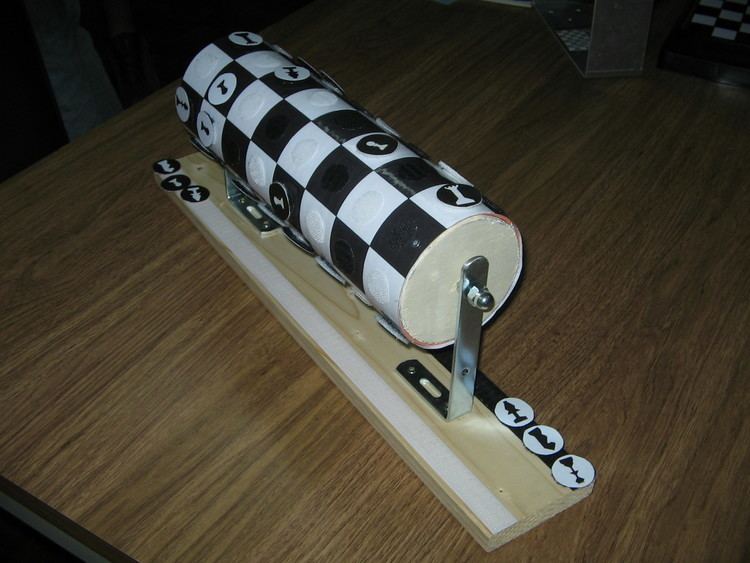 | ||
Cylinder chess (or Cylindrical chess) is a chess variant with an unusual board. The game is played as if the board were a cylinder, with the left side of the board joined to the right side. According to Bill Wall, in 947 in a history of chess in India and Persia, the Arabic historian Ali al-Masudi described six different variants of chess, including astrological chess, circular chess and cylinder chess.
Contents
Cylindrical board is also used in chess problems.
Rules and gameplay
The game is played as if there is no edge on the side of the board. When a piece goes off the right edge of the board in cylinder chess, it reappears on the left edge; when a piece goes off the left edge, it reappears on the right edge.
It is legal to move a rook from a3 to h3, even if there is a piece on b3, since the rook can move left from a3. A bishop on c1 can go to h4, by moving from c1 to a3, and then going up and left from a3 to h4. Moves that do not change the position, like rook a3-a3 (assuming the 3rd rank is empty), are usually not allowed, but sometimes they are in some problems. It is allowed to capture en passant over the board edge. For example, if White has a pawn on a5, Black on h7 and Black plays h7-h5, White can capture it: axh6.
Bishops are more valuable in this variant. And, unlike in standard chess, a king and rook cannot enforce checkmate against a lone king on the cylindrical board.
The game is sometimes played with changed rules for castling:
Some cylinder chess problems allow moves that don't change the position (null moves). At the right an example of such a problem is shown. The solution is to put Black in zugzwang by playing 1.Rh4-h4. Now, after any move by Black, White has a mate. The move 1.Rg4 doesn't work because of 1...Ka5 threatening to capture the rook on h6.
Strategy
In Cylinder chess, the traditional hierarchy of queen, rook, knight/bishop, pawn, is altered, with the bishop becoming more versatile and therefore more deadly than the rook, thereby switching the positions of the bishop and rook. Also, the traditional important center squares, and the common moves of pawn e4, d4, e5, d5, become very vulnerable moves in Cylinder chess, due to the fact that it opens up the player's center to attacks by the bishops which have been allowed access to the side squares.
Horizontal Cylinder chess and Toroidal chess
In Horizontal Cylinder chess, first and last rank are connected. In Toroidal chess the board has the form of a torus. One can get a toroidal board by connecting the first and last ranks of the cylindrical board. On the toroidal board, even king and queen can't checkmate a lone king, but two rooks and a king are sufficient.
See the Torus Chess link below for a toroidal variant that can be played, with an explanation of moves and strategy. The diagram on the right shows the starting position for play on a standard board, using toroidal geometry.
